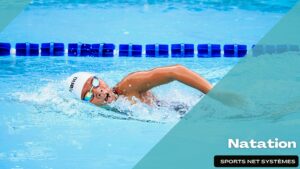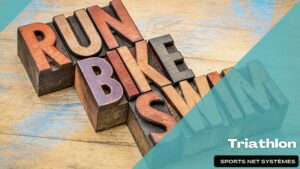The best butterfliers combine grace and power in what seems like effortless forward motion. The primary point of technique that these butterfliers share is good body position. While the line of the stroke is characterized by a wave or rocking motion, it is a stable, high hip floating position that is key to a good stroke. This position balances the stroke, and integrates the actions of both the upper and lower body. Often, swimmers attempt to achieve the rocking effect of the butterfly by folding both forward and back at the hips. Doing so eliminates core stability, lowers the hips, and eliminates balance in the stroke. It can also lead to back pain. The goal of the following drills for the butterfly body position is to develop a firm core, high hip body position for better balance and integration of butterfly actions.
Taking a Bow
THE PURPOSE OF THIS DRILL
- Learning to stabilize motion using the abdominals
- Isolating upper body motion
- Using abdominal muscles to maintain a straight spine
HOW TO DO THIS DRILL
- Step 1 : – Stand with your head, back and legs against a wall, arms at your sides. Notice at the small of your back, you can fit your hand between the wall and your back. To achieve a truly firm core, you must straighten your spine, and eliminate this space at the small of your back. To do so, pull your belly button back toward your spine, and press the small of your back into the wall. Notice that to do this, you contract your abdominal muscles.
- Step 2 : – Maintaining your spine straight with contracted abdominals, press your chest forward away from the wall about six inches, as if taking a bow. Keep your hips and lower body firmly against the wall, controlling the speed of the movement. Hold this position for five seconds, stabilizing your position with your abdominal muscles.
- Step 3 : – Keeping your core firm, return your back to the wall. Check to see if you have maintained a straight spine by trying to fit your hand between the wall and the small of your back. Repeat the bow, actively using your abdominal muscles to maintain a straight spine, and to stabilize your upper body throughout the bow. Notice that your hips remain stable through the entire range of motion.
- Step 4 : – Now, try the same bowing action without the support of the wall. Maintain a straight spine. Keep your hips stable. Use your abdominal muscles to control the movement of your upper body, while your lower body remains still.

DRILL FEEDBACK CHART
| Problem | Modification |
| It is much harder without the support of the wall. | Yes, harder than it would seem. Start by rocking your pelvis forward a bit. Then, engage your abdominal muscles to stabilize your upper body in both directions during this motion. |
| I can’t keep my hips stable without the wall. | Make sure your head is aligned with your straight spine. Also make sure you are not bowing too deeply. Try starting with only a three-inch bow, focusing on moving your upper body only. Contract your abdominal muscles going into the bow to stabilize your movement. |
| I am using my back muscles. | It is tempting to use the muscles of the back. As land animals, we spend most of our time vertical, and we are used to depending on the muscles of the back for stability and balance. In the water, however, we move horizontally, and to achieve the best stabilization and balance, we must use primarily the muscles of the abdomen. |
Weight Shifting
THE PURPOSE OF THIS DRILL
- Feeling both natural and downhill body positions
- Learning to shift weight forward
- Developing effective core tension and stability
HOW TO DO THIS DRILL
- Step 1 : – Lay in the water, arms at your sides. Look at the bottom of the pool. Feel your natural floating position. In butterfly, you have to learn to actively change from your natural float to a downhill position. You must learn to shift your weight forward so your chest is lower than your hips, during every single stroke. To do this, you must maintain a firm core and upper body, from your neck through to your hips.
- Step 2 : – Holding your core firm, press your chest down into the water. Allow your chest to be lower than your hips. Feel your weight shift forward. Now release your chest press and allow your body to return to its natural float.
- Step 3 : – Again press your chest down into the water, so you achieve a downhill float. Maintaining your firm core, release your chest press and return to your natural float. Repeat several times in a row, maintaining a firm core in both directions in a gentle, rhythmic action. Notice that as your press and release your chest, your hips remain stable in the water. This is the essential position of the butterfly. All other actions depend on this high hip floatation that shifts between the natural and downhill upper body positions.
- Step 4 : – Now push off the wall, with your arms extended over your head. Feel your natural float, then, maintaining your firm core, change it, shifting your weight forward by pressing your chest into the water. Release and do it again, maintaining high hips.
- Step 5 : – Repeat the upper body shift of weight several times, from natural to downhill and back again. Feel the gentle wave produced by alternating your floating position. Feel your hips remain stable.

DRILL FEEDBACK CHART
| Problem | Modification |
| I can’t breathe. | This drill is not meant to be done for an extended time. Take a big breath before you start, then stand up when you need more air. Start again with a new breath. |
| When I press my chest down, my legs sink. | Hold your core firm. Avoid folding at the hips or waist. Just press your chest down a few inches, just enough so your weight shifts forward. When your chest is the lowest point of your float, then release it. Switch your weight about once every two seconds in a rhythmic motion. |
| This hurts my back. | It is important that you hold your core firm in both directions, or your back will take a lot of stress. Also, when you return to your natural float, don’t force it. Simply allow your body to resume its natural position. If it continues to hurt you, just don’t do it. |













